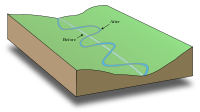
Photo from wikipedia
Abstract The preserved deposits of fluvial meander belts typically take the form of patchworks of sand-prone bar-form elements bordered by genetically related, muddy channel fills. In meander belts that act… Click to show full abstract
Abstract The preserved deposits of fluvial meander belts typically take the form of patchworks of sand-prone bar-form elements bordered by genetically related, muddy channel fills. In meander belts that act as hydrocarbon reservoirs, characteristics of sedimentary architecture, including the geometry of point-bar elements and the internal compartmentalization exerted by the presence of mud-prone abandoned channel fills, control the effectiveness of primary and enhanced hydrocarbon recovery. Therefore, a quantitative description of meander-belt architectures is desired to provide constraints to subsurface predictions. To this end, an examination of sedimentological datasets, enabled by database-assisted analysis, is undertaken. Sixty-four database case studies of modern, ancient outcropping and subsurface fluvial depositional systems are characterized in a quantitative manner, to assess the relative importance of different styles of lithological compartmentalization, and to provide constraints that can be applied to inform predictions of the geometry and connectivity of bar-scale sandbodies in meander-belt reservoirs. The results of this study include: (i) a set of empirical relationships that relate dimensional parameters describing the geometry of point-bar elements, associated channel fills, channel complexes and potentially unswept compartments; (ii) probabilistic descriptions that relate well density to both the proportion of compartments intersected by a well array, and the maximum volume of untapped bar-form compartments. The resulting predictive tools can be applied to assist reservoir development and production, either directly or through incorporation into reservoir models. For example, it is shown how to use these quantitative constraints to predict the likely volume of point-bar reservoir compartments with potential bypassed hydrocarbons, and to optimize drilling strategies (e.g., whether and how to perform infill drilling or horizontal drilling), by providing a measure of the likely presence, size, spacing, and orientation of bypassed hydrocarbon volumes.
Journal Title: Marine and Petroleum Geology
Year Published: 2017
Link to full text (if available)
Share on Social Media: Sign Up to like & get
recommendations!